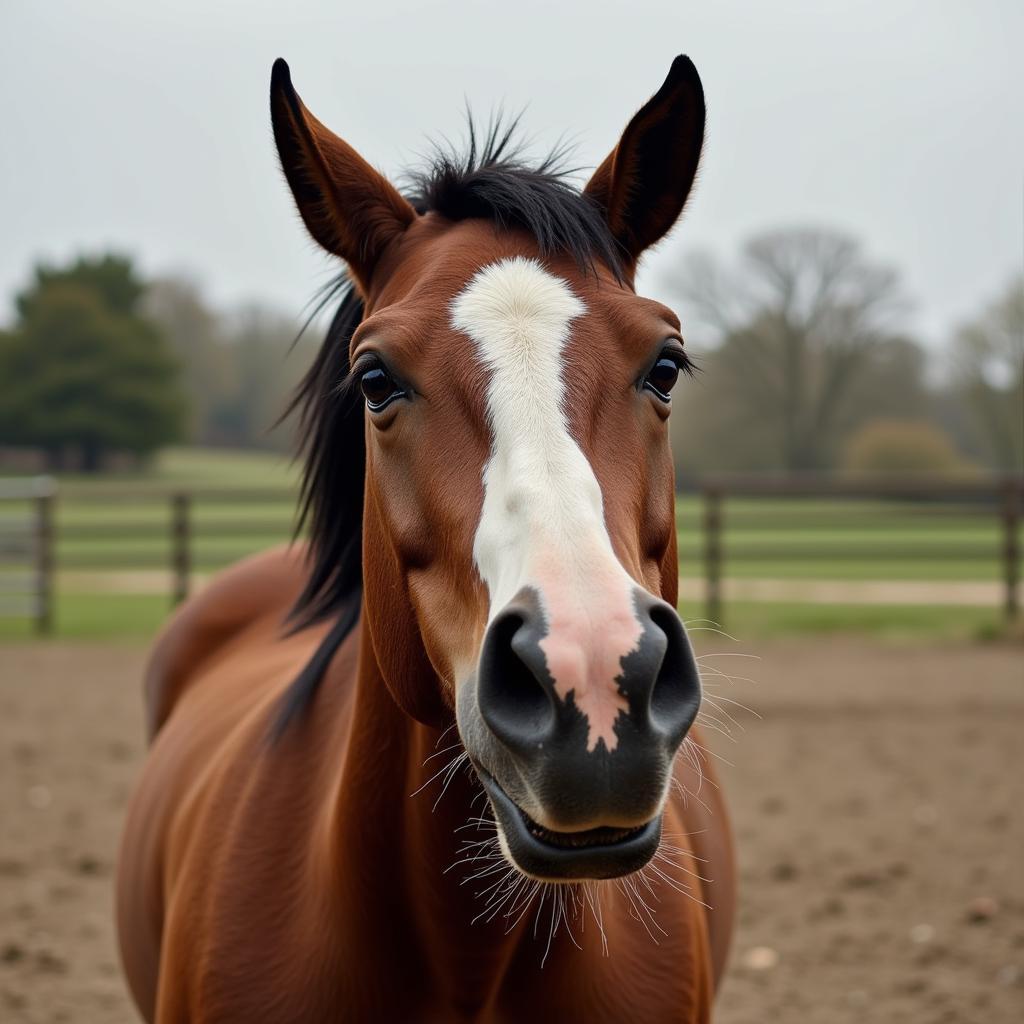A Horse Confused can display a variety of behaviors, from subtle ear twitches to dramatic displays of anxiety. Recognizing these signs is crucial for any horse owner or enthusiast. This article delves into the intricacies of equine behavior, providing valuable insights into what might be causing your horse’s confusion and offering practical advice on how to address it.
Horses, like any sentient beings, experience a range of emotions. When a horse appears confused, it’s often a sign of underlying stress, anxiety, or uncertainty. This could stem from a change in their routine, a new environment, or even subtle shifts in their social dynamics. Understanding the nuances of equine body language is key to deciphering what’s going on in their minds.
Decoding Equine Confusion: Signs and Symptoms
A confused horse might exhibit a range of behaviors, some more obvious than others. Here are some common signs to watch out for:
- Head tossing or shaking: This can be a sign of frustration or an attempt to clear their head, literally.
- Pinned ears: While often associated with aggression, pinned ears can also indicate fear or anxiety, contributing to a confused state.
- Restlessness and pacing: A horse unable to settle down might be struggling to process their surroundings.
- Vocalizations: Whinnying, snorting, or groaning can all be expressions of confusion or distress.
- Freezing or hesitant movement: A confused horse may appear “stuck” as they try to make sense of a situation.
 Confused Horse Showing Head Shaking Behavior
Confused Horse Showing Head Shaking Behavior
Understanding the context in which these behaviors occur is vital. A horse that’s normally calm and suddenly starts exhibiting these signs is more likely experiencing confusion than a horse with a history of anxiety or behavioral issues.
What Causes Equine Confusion?
A variety of factors can contribute to a horse appearing confused. Some of the most common causes include:
- Changes in routine: Horses are creatures of habit. Introducing new routines, such as changes in feeding times, training schedules, or even different handlers, can cause confusion.
- New environments: Moving to a new stable, traveling to a competition, or even a change in pasture can be disorienting for a horse. They rely heavily on familiar sights, sounds, and smells.
- Inconsistent training: Conflicting cues or inconsistent training methods can leave a horse unsure of what’s expected of them. This is especially true for young horses or those just starting their training.
- Medical conditions: Sometimes, underlying medical conditions, such as vision or hearing problems, can contribute to a horse appearing confused.
If you suspect a medical issue, it’s crucial to consult with a veterinarian. They can perform a thorough examination and rule out any underlying health problems.
Addressing Equine Confusion: Tips and Strategies
If you notice your horse displaying signs of confusion, there are several steps you can take to help them:
- Provide consistency: Maintain a regular routine for feeding, training, and turnout. This will help your horse feel secure and predictable.
- Introduce changes gradually: If a change is unavoidable, introduce it slowly. For example, if moving to a new stable, allow your horse to explore the new surroundings gradually, starting with short visits before a full move.
- Use clear and consistent cues: Ensure all handlers are using the same cues and training methods. This will avoid conflicting signals and minimize confusion.
- Create a calm and predictable environment: Minimize stressors as much as possible. A calm and quiet environment can help a horse feel more secure.
Remember, patience is key. It may take time for your horse to adjust to new situations or overcome their confusion. Building trust and providing a supportive environment are essential for their well-being. You might find some helpful tips on training a horse to bow, which can be a fun and rewarding activity. For those interested in specific breeds, we have resources on Hershberger horses and Brindle horses for sale. And for common hoof issues, we offer information about corns in horses. If you’re unsure about certain horse-related terms, check out our article on horse lamo.
Conclusion
Recognizing and addressing a horse confused is essential for responsible horse ownership. By understanding the various signs of confusion, potential causes, and implementing appropriate strategies, you can help your horse navigate challenging situations and maintain their physical and emotional well-being. Remember, a calm and consistent approach is often the best way to support a confused horse.
FAQ:
- What are the most common signs of a confused horse?
- Can changes in routine cause confusion in horses?
- How can I help my horse adjust to a new environment?
- What role does consistent training play in preventing confusion?
- When should I consult a veterinarian about my horse’s behavior?
- Can medical conditions cause a horse to appear confused?
- How long does it take for a horse to overcome confusion?
Suggested Further Reading:
- How to Teach Horse to Bow
- Hershberger Horses
- Corns in Horses
Need more help? Contact us at Phone Number: 0772127271, Email: [email protected] or visit us at QGM2+WX2, Vị Trung, Vị Thuỷ, Hậu Giang, Việt Nam. We have a 24/7 customer service team ready to assist you.